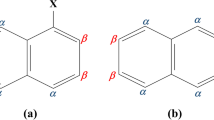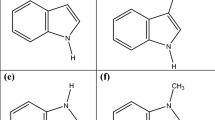Abstract
The position of hydrogen in the structure of topaz-OH was determined by means of ab-initio quantum-mechanic calculations. Static lattice energy calculations predict the existence of four non-equivalent positions of protons, which are characterized by O4–H1... O1, O4–H2... O2, O4–H3... O3 and O4–H4... O4 hydrogen bonds. The distribution of the protons between positions of local equilibrium is controlled by the proton–proton avoidance rule and the strength of the hydrogen bonds. The most favourable configuration of hydrogen atoms is achieved for adjacent protons, which form O4–H3... O3 and O4–H4... O4 hydrogen bonds, respectively. The thermal excitation of atoms at a temperature of 55 K is large enough for the hydrogen atoms occasionally to change their positions to form O4–H1... O1 and O4–H2... O2 bonds. At ambient pressures and higher temperatures the protons are in a dynamic exchange between the allowed positions of local minima. As a consequence, for nearly room-temperature conditions, the dynamic change between different structural configurations leads to the violation of all possible symmetry elements and with that to space group #E5/E5#1. The flipping of the protons between different sites is achieved by simple rotation of the OH-dipole and does not produce any significant distortion of the framework of topaz, whose symmetry remains that of the space group Pbnm. Therefore, no reduction of symmetry has been observed in former X-ray studies on topaz-OH. Calculated IR absorption spectra of topaz-OH were found to be in good agreement with measured spectra. According to the calculations, the two favourable configurations of protons might correspond to the measured peak splitting within the OH-stretching range. An experimentally observed low-frequency band at 3520 cm−1 was assigned to the OH-stretching of the O4–H3... O3 bond, while the band at 3600 cm−1 was attributed to OH-stretching of the O4–H4... O4 hydrogen bond. The broad peak in FAR-IR frequency range at 100–150 cm−1 is attributed to the stretching of H3... O3 and H4... O4 contacts. The rate of proton exchange at 670 K among different sites was estimated by ab-inito molecular dynamic simulations. The calculations predict that flipping of adjacent protons between O4–H3... O3 and O4–H4... O4 bonds at 670 K occur at a rate of about 1.96 THz.
Similar content being viewed by others
Acknowledgments.
The authors are grateful to Dr. M. Iannuzzi, Prof. M. Bernasconi and Prof. M. Parrinello for fruitful discussions. We appreciate access to computational facilities of the Potsdam Institute for Climate Impact Research and CSCS-Manno. The authors also thank two anonymous readers for their thoughtful reviews.
Author information
Authors and Affiliations
Corresponding author
Rights and permissions
About this article
Cite this article
Churakov, S., Wunder, B. Ab-initio calculations of the proton location in topaz-OH, Al2SiO4(OH)2 . Phys Chem Minerals 31, 131–141 (2004). https://doi.org/10.1007/s00269-003-0365-8
Received:
Accepted:
Issue Date:
DOI: https://doi.org/10.1007/s00269-003-0365-8




